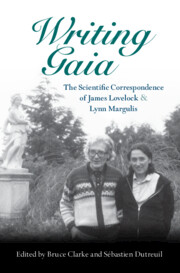Book contents
- Writing Gaia: The Scientific Correspondence of James Lovelock and Lynn Margulis
- Reviews
- Writing Gaia: The Scientific Correspondence of James Lovelock and Lynn Margulis
- Copyright page
- Epigraph
- Table of Contents
- Figures
- Contributors
- Foreword by James Lovelock
- Preface
- Acknowledgements
- Introduction
- Part I 1970–1972
- 1970
- 1971
- 1972
- Part II 1973–1979
- Part III 1980–1991
- Part IV 1992–2007
- Part V Commentaries on Lovelock and Margulis
- Glossary of Names
- Glossary of Terms
- Bibliography
- Index
1970
from Part I - 1970–1972
Published online by Cambridge University Press: 28 July 2022
- Writing Gaia: The Scientific Correspondence of James Lovelock and Lynn Margulis
- Reviews
- Writing Gaia: The Scientific Correspondence of James Lovelock and Lynn Margulis
- Copyright page
- Epigraph
- Table of Contents
- Figures
- Contributors
- Foreword by James Lovelock
- Preface
- Acknowledgements
- Introduction
- Part I 1970–1972
- 1970
- 1971
- 1972
- Part II 1973–1979
- Part III 1980–1991
- Part IV 1992–2007
- Part V Commentaries on Lovelock and Margulis
- Glossary of Names
- Glossary of Terms
- Bibliography
- Index
Summary
When her first letter arrived in 1970, Lovelock’s personal research program on planetary atmospheres, then developing through a concept he has privately named “Gaia,” had already taken on a fair amount of definition. He informed her, “I am in the course of writing a paper on the Earth’s atmosphere as a biological cybernetic system” (Letter 1). This striking formulation of a biological cybernetic system is the curt technical description for which “Gaia” will become the shorthand trademark. This phrase was already present in a paper written on behalf of NASA, delivered in 1968 at a meeting of the American Astronautical Society and published in 1969, “Planetary atmospheres: compositional and other changes associated with the presence of life” (see Letter 9).
- Type
- Chapter
- Information
- Publisher: Cambridge University PressPrint publication year: 2022

